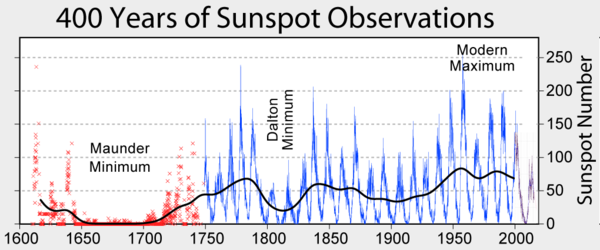Difference between revisions of "Solar Weather"
m (→Introduction: add link) |
(→Links: add NOAA link) |
||
| (5 intermediate revisions by the same user not shown) | |||
| Line 6: | Line 6: | ||
== The Solar Cycle == | == The Solar Cycle == | ||
Solar activity follows a cycle that is about eleven years long. That is, there are eleven Earth years between the points of the cycle where we observe the lowest number of sunspots, solar flares, ejection of solar material, etc. | |||
[[File:Sunspot_Numbers.png|600px|thumb|left|400 year sunspot history]] | |||
== Current Conditions == | == Current Conditions == | ||
We are currently in the downward side of [https://en.wikipedia.org/wiki/Solar_cycle_24 solar cycle number 24] which reached two peaks: the first in 2011 and another peak in 2014. [https://en.wikipedia.org/wiki/Solar_cycle_23 Solar cycle 23] reached a minimum around the year 2002. | |||
=== What does that mean for amateur radio operators? === | |||
For users of VHF/UHF frequencies (30 MHz and up), it does not mean much. For users of HF transceivers, you may notice changes in your ability to hear and be heard on certain bands. | |||
| Line 19: | Line 24: | ||
* [http://www.hamqsl.com/solar.html Solar conditions] | * [http://www.hamqsl.com/solar.html Solar conditions] | ||
* [http://www.solarham.net/ SolarHam] | * [http://www.solarham.net/ SolarHam] | ||
* [https://www.youtube.com/channel/UCkXjdDQ-db0xz8f4PKgKsag Tamitha Skov YouTube channel] | |||
* [http://www.swpc.noaa.gov/communities/space-weather-enthusiasts NOAA's Space Weather Dashboard] | |||
Latest revision as of 08:28, 20 June 2017
Introduction
Believe it or not, activity on the Sun effects the propagation of radio waves here on Earth. While disturbances are rarely noticeable for local communications using VHF/UHF bands, operators using frequencies in the HF range pay close attention to energy levels in the Earth's ionosphere.
The Solar Cycle
Solar activity follows a cycle that is about eleven years long. That is, there are eleven Earth years between the points of the cycle where we observe the lowest number of sunspots, solar flares, ejection of solar material, etc.
Current Conditions
We are currently in the downward side of solar cycle number 24 which reached two peaks: the first in 2011 and another peak in 2014. Solar cycle 23 reached a minimum around the year 2002.
What does that mean for amateur radio operators?
For users of VHF/UHF frequencies (30 MHz and up), it does not mean much. For users of HF transceivers, you may notice changes in your ability to hear and be heard on certain bands.
